All the solutions provided in McGraw Hill Math Grade 5 Answer Key PDF Chapter 3 Lesson 12 Interpret the Remainder will give you a clear idea of the concepts.
McGraw-Hill My Math Grade 5 Answer Key Chapter 3 Lesson 12 Interpret the Remainder
Math in My World
Example 1
A state park has 257 evergreens to plant equally in 9 areas. How many evergreens are planted in each area? What does the remainder represent?
Divide 257 ÷ 9.

1. Place the first digit.
25 ÷ 9 ≈ 2
Put 2 in the tens place of the quotient.
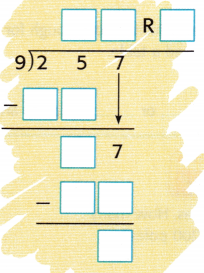
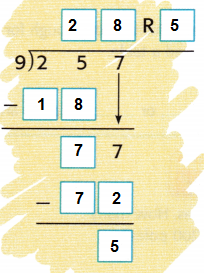
2. Multiply. 9 × 2 = 18
Subtract. 25 – 18 = 7
Compare. 7 < 9
3. Divide the ones.
77 ÷ 9 ≈ 8 9 × 8 = 72
9 × 8 = 72
77 – 72 = 5
5 < 9
4. Write the remainder.
The remainder is 5.
5. Interpret the remainder, 5.
The remainder, 5, means there are 5 evergreens left over.
So, the park plants 28 evergreens in each area and 5 are left.
Example 2
There are 174 guests invited to a dinner. Each table seats 8 guests. How many tables are needed?
Divide 174 ÷ 8.
1. Place the first digit.
17 ÷ 8 ≈ 2
Put 2 in the tens place of the quotient.
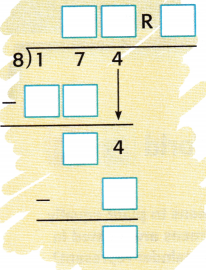

2. Multiply. 8 × 2 = 16
Subtract. 17 – 16 = 1
Compare. 1 < 8
3. Divide the ones.
14 ÷ 8 ≈ 1
1 × 8 = 8
14 – 8 = 6
6 < 8
4. Write the remainder.
The remainder is 6.
5. Interpret the remainder, 6.
There are 6 guests left over, which is not enough for a full table of 8. But, they also need a table.
So, a total of 20 + 1, or 20 tables are needed.
Talk Math
Discuss the different ways you can interpret the remainder.
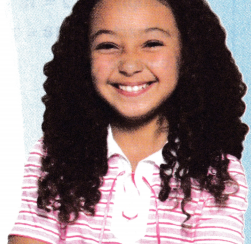
Answer:
1. By Ignoring the remainder.
2. By interpreting the remainder as a fraction or decimal.
3. Round the remainder up.
Explanation:
Ignoring the remainder means not using the remainder in the answer at all.
257 ÷ 9 = 28 R 5
In interpret the remainder we include the remainder in the answer and report it as a fraction or decimal.
18 ÷ 4 = 4 R 2
So, it is interpreted as 4.5
Check: 4.5 x 4 = 18
Round up the remainder means, adding one more to the quotient.
200 ÷ 60 = 3 R 20
3 + 1 = 4
Guided Practice
Question 1.
A tent is put up with 7 poles. How many tents can be put up with 200 poles?
Divide 200 ÷ 7.
Interpret the remainder, ____
There are ____ poles left over, which is not enough for another tent.
So, a total of ____ tents can be put up.
Answer:
Divide 200 ÷ 7 = 28
Interpret the remainder, 4.
There are 4 poles left over, which is not enough for another tent.
So, a total of 28 tents can be put up.
Explanation:

2. Multiply. 7 × 2 = 14
Subtract. 20 – 14 = 6
Compare. 6 < 7
3. Divide the ones.
60 ÷ 7 ≈ 8
7 × 8 = 56
60 – 56 = 4
4 < 7
4. Write the remainder.
The remainder is 4.
5. Interpret the remainder, 4.
There are 4 poles left over, which is not enough for another tent.
So, a total of 28 tents can be put up.
Independent Practice
Solve. Explain how you interpreted the remainder.
Question 2.
There are 50 students traveling in vans on a field trip. Each van seats 8 students. How many vans are needed?
Answer:
Divide 50 ÷ 8 = 6
The remainder is 2.
Interpret the remainder, 2.
There are 2 students left over, which is not enough for another van.
So, a total of 6 vans can be put up.
Explanation:
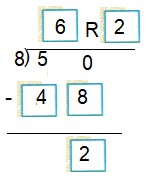
Multiply. 8 × 6 = 48
Subtract. 50 – 48 = 2
Compare. 2 < 8
The remainder is 2.
Interpret the remainder, 2.
There are 2 students left over, which is not enough for another van.
So, a total of 6 vans can be put up.
Question 3.
How many payments of $10 would it take Samuel to purchase the scooter shown at the right?
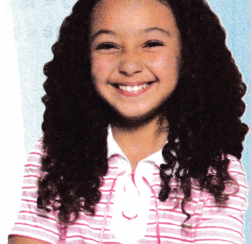
Answer:
Divide 79 ÷ 10 = 7
The remainder is 9.
There are $9 left over, which is not enough for another payment.
So, a total of 7 payments can be put up.
Explanation:
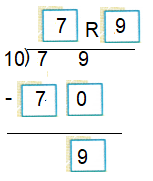
Multiply. 7 × 10 = 70
Subtract. 79 – 70 = 9
Compare. 9 < 10
The remainder is 9.
There are $9 left over, which is not enough for another payment.
So, a total of 7 payments can be put up.
Question 4.
Mrs. Hodges made 144 muffins for a bake sale. She puts them into tins of 5 muffins each. How many tins of muffins can she make?
Answer:
Divide 144 ÷ 5 = 28
The remainder is 4.
There are 4 muffins left over, which is not enough for another tin.
So, a total of 28 tins can be put up.
Explanation:
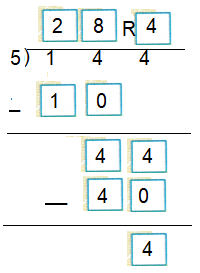
Multiply. 2 × 5 = 10
Subtract. 14 – 10 = 4
Compare. 4 < 5
Divide the ones.
44 ÷ 5 ≈ 8
5 × 8 = 40
44 – 40 = 4
4 < 5
The remainder is 4.
There are 4 muffins left over, which is not enough for another tin.
So, a total of 28 tins can be put up.
Question 5.
How many 8-foot sections of fencing are needed for 189 feet of fence?
Answer:
Divide 189 ÷ 8 = 23
The remainder is 5.
There are 5, 8-foot sections of fencing left over, which is not enough for another fence.
So, a total of 23, 8-foot sections of fencing are needed.
Explanation:
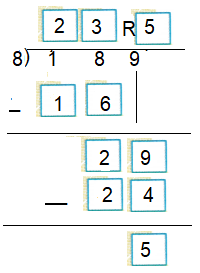
Multiply. 2 × 8 = 16
Subtract. 18 – 16 = 2
Compare. 2 < 8
Divide the ones.
29 ÷ 8 ≈ 3
3 × 8 = 24
29 – 24 = 5
5 < 8
The remainder is 5.
There are 5, 8-foot sections of fencing left over, which is not enough for another fence.
So, a total of 23, 8-foot sections of fencing are needed.
Problem Solving
Solve Exercises 6-8. Explain how you interpreted the remainder.
Question 6.
Mathematical PRACTICE 2 Reason Students on the softball team earned $295 from a car wash. How many team banners can they buy if each banner costs $8?
Answer:
Divide $295 ÷ 8 = $36
The remainder is 7.
There are $7 left over, which is not enough for another banner.
So, a total of 36 banners can be purchased.
Explanation:
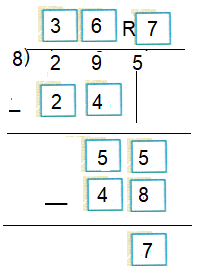
Multiply. 3 × 8 = 24
Subtract. 29 – 24 = 5
Compare. 5 < 8
Divide the ones.
55 ÷ 8 ≈ 6
6 × 8 = 48
55 – 48 = 7
7 < 8
The remainder is 7.
There are $7 left over, which is not enough for another banner.
So, a total of 36 banners can be purchased.
Question 7.
Valerie has 20 stuffed animals. She wants to store them in plastic bags. She estimates she can fit three stuffed animals in each bag. How many bags will she need?
Answer:
Divide 20 ÷ 3 = 6
The remainder is 2.
There are 2 left over, which is not enough for another bag.
So, a total of 6 bags can be put up.
Explanation:
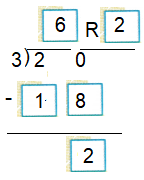
Multiply. 6 × 3 = 18
Subtract. 20 – 18 = 2
Compare. 2 < 3
The remainder is 2.
There are 2 left over, which is not enough for another bag.
So, a total of 6 bags can be put up.
Question 8.
How many 6-ounce cups can be filled from 4 gallons of juice? (Hint: 1 gallon = 128 ounces)
Answer:
85 cups are filled.
Explanation:
1 gallon = 128 ounces.
4 gallons = 128 x 4 = 512 ounces.
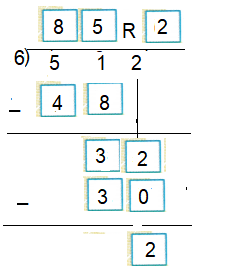
Multiply. 8 × 6 = 48
Subtract. 51 – 48 = 3
Compare. 3 < 6
Divide the ones.
32 ÷ 6 ≈ 5
5 × 6 = 30
32 – 30 = 2
2 < 5
The remainder is 2.
There are 2 left over ounce, which is not enough for another cup.
So, a total of 85 cups can be filled.
HOT Problems
Question 9.
Mathematical PRACTICE 1 Make Sense of Problems If the divisor is 30, what is the least three-digit dividend that would give a remainder of 8? Explain.
Answer:
Least three-digit number is 128
Explanation:

Divisor is 30,
Let quotient be x.
Remainder is 8.
x ÷ 30 = 8
30 x 4 +8 = x
x = 30 x 4 + 8 = 128
Question 10.
? Building on the Essential Question How can I interpret the remainder?
Answer:
First divide the given number,
Multiply. Quotient with divisor.
Subtract and then Compare.
Divide the ones and tens if needed.
Then write the remainder.
Explanation:
For example;
Divide 295 ÷ 8 = 36
Multiply. 3 × 8 = 24
Subtract. 29 – 24 = 5
Compare. 5 < 8
Divide the ones.
55 ÷ 8 ≈ 6
6 × 8 = 48
55 – 48 = 7
7 < 8
The remainder is 7.
McGraw Hill My Math Grade 5 Chapter 3 Lesson 12 My Homework Answer Key
Practice
Question 1.
Four, employees of Papa Tony’s Pizza are cleaning up at the end of a busy night. There is a list of 43 clean-up tasks that need to be completed. If each employee does the same number of tasks, how many tasks should each employee do? Solve. Explain how you interpreted the remainder.
Answer:
10 tasks.
Explanation:
Number of employees = 4
List of clean up tasks = 43
If each employee does the same number of tasks,
Number of tasks should each employee 43 ÷ 4 = 10
10 x 4 = 40
43 – 40 = 3
Remainder is 3, which is one less task for one person.
So, each can complete 40 tasks equally.
Problem Solving
Solve Exercises 2 and 3. Explain how you interpreted the remainder.
Question 2.
Mrs. Flores is buying scrapbooks for her store. Her budget is $350. Each scrapbook costs $9. How many scrapbooks can she buy?
Answer:
38 scrap books.
Explanation:
Mrs. Flores budget is $350.
Each scrapbook costs $9.
Number of scrapbooks she can buy,
$350 ÷ $9 = 38
38 x 9 = 242
250 – 242 = 8
So, 8 is the remainder.
Question 3.
Water stations will be placed every 400 meters of a 5-kilometer race. How many water stations are needed?
(Hint: 1 kilometer = 1,000 meters)
Answer:
1 kilometer = 1,000 meters.
5 kilometers = 1,000 x 5 = 5,000 meters.
Water stations will be placed every 400 meters.
Number of water stations needed 5,000 ÷ 400 = 12
12 x 4 = 48
50 – 48 = 2
So, 2 is the remainder.
Question 4.
Mathematical PRACTICE 4 Model Math Write a real-world problem that is represented by the division problem 38 ÷ 5 = 7 R3 in which it makes sense to round the quotient up to 8.
Answer:
Evan is $38. She want to buy pens. Each pen costs $5. How many pens can she buy?
Explanation:
38 ÷ 5 = 7
7 x 5 = 35
38 – 35 = 3
So, remainder is 3.
Test Practice
Question 5.
Three yards of fabric will be cut into pieces so that each piece is 8 inches long. How many pieces can be cut? (Hint: 1 yard = 36 inches)
A. 4 pieces with 4 inches left over
B. 10 pieces with 6 inches left over
C. 13 pieces with 4 inches left over
D. 16 pieces with 6 inches left over
Answer:
Option (C)
Explanation:
Three yards of fabric will be cut into pieces so that each piece is 8 inches long.
1 yard = 36 inches
3 x 36 = 108 inches
108 ÷ 8 = 104
13 x 4 = 104
108 – 104 = 4 inches
So, 4 is the remainder.